On this page you can find the results of our research and statistics on sexual offences within police forces in the UK.
Our Research Into Sexual Offences In The UK
Legal Expert has conducted a series of Freedom of Information requests on the number of sexual offences that have been recorded in UK police forces within the last 12 months (from October 2022 to October 2023).
Below, you can find the results for each police force.

How Legal Expert Can Help You
Legal Expert offers a specialist legal support and claims service for anyone who has been subjected to a sexual offence, such as abuse, assaults or rape.
We understand how difficult and traumatic these incidents can be, especially within a working environment or at the hands of those in society we are meant to trust. If you’d like to speak with us in confidence you can do so by calling 0800 073 8804
You can also message us via our live chat box, or you can submit a claim enquiry online
Sexual Offences In UK Police Forces
To browse the results by police force, please see below. For more information on our research and statistics on sexual offences, head here.
Wiltshire Police
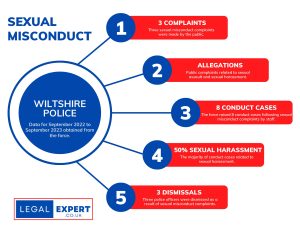
Wiltshire Police has investigated 8 allegations of sexual misconduct made by staff this year.
The majority of conduct cases raised by the force related to sexual harassment, which accounted for 50% of allegations between October 2022 to October 2023.
Sexual assault was also investigated by the force and made up 37.5% of allegations.
Further data obtained from Wiltshire Police via a Freedom of Information request revealed that members of the public made 3 complaints about sexual misconduct.
Amongst the allegations included sexual assault and an abuse of position for a sexual purpose.
The force has dismissed 3 police officers for sexual misconduct in the same period.
Leicestershire Constabulary

Leicestershire Constabulary has investigated 32 allegations of sexual misconduct made by staff in the last year.
The data, which covers the period from October 2022 to October 2023, revealed that the majority of allegations related to sexual harassment (53%).
Other common allegations included relationships with colleagues where there was a power imbalance (28%), sexual assault and abuse of position for sexual purpose (both 9%)
Furthermore, the force received 6 complaints from the public in relation to sexual misconduct.
Amongst the allegations included sexual assault and sexual harassment.
As a result of sexual misconduct allegations made against Leicestershire Constabulary in the last year, a total of 3 police officers have been dismissed.
Gloucestershire Constabulary
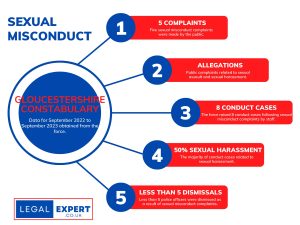
Gloucestershire Constabulary have investigated 8 allegations of sexual misconduct made by staff this year.
Sexual harassment accounted for half the allegations between October 2022 to October 2023.
Another common allegation investigated by the force was sexual assault (37.5%).
In addition, a Freedom of Information request submitted to Gloucestershire Constabulary revealed that 5 complaints about sexual misconduct had been made by the public.
Sexual assault was the most common complaint received by the force.
Gloucestershire Constabulary stated that less than 5 police officers were dismissed or would have been dismissed if not already resigned from the force.
Surrey Police
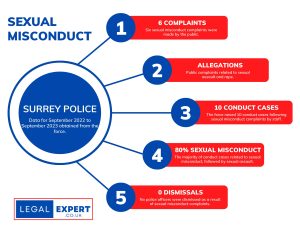
Surrey Police has investigated 10 complaints relating to sexual misconduct made by staff this year.
A total of 8 allegations were made regarding sexual misconduct between October 2022 to October 2023.
In addition, a further 2 allegations were made in relation to sexual assault
Data obtained from Surrey Police via a Freedom of Information request revealed that 5 allegations of sexual assault were made from members of the public.
A member of the public also made an allegation of rape against the force.
No police officers were dismissed from the force for sexual misconduct during this period.
Derbyshire Constabulary
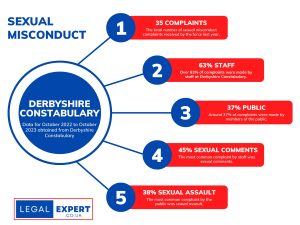
Derbyshire Constabulary received 35 complaints regarding sexual misconduct in the last year.
More than 63% of sexual misconduct complaints were made by staff, whilst the remaining 37% were made by the public.
The most common complaint made by staff between October 2022 to October 2023 related to sexual comments, accounting for 45% of complaints.
Around 23% of complaints made internally were caused by sexual harassment.
In contrast, the most common complaint made by members of the public were to do with sexual assault or abuse of position for sexual purpose (38% and 31%, respectively).
However, no officers were dismissed for sexual misconduct in the last year.
West Midlands Police
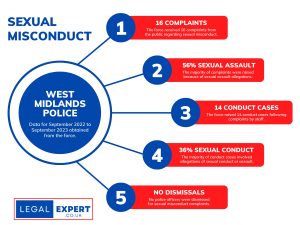
West Midlands Police have received 16 complaints from the public regarding sexual misconduct in the last year.
Over 56% of those complaints were raised due to allegations of sexual assault.
Other complaints involved incidents of sexual harassment and an abuse of position for sexual purposes.
The data further revealed that 14 conduct cases were raised following complaints of sexual misconduct from staff between October 2022 to October 2023.
Around 36% related to sexual assault or other sexual conduct, whilst 28% involved incidents of sexual harassment.
No police officers were dismissed from the force for sexual misconduct in the same period.
Devon and Cornwall Police
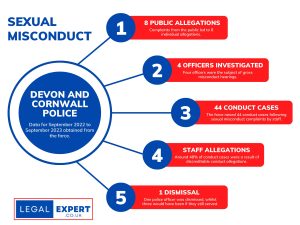
Devon and Cornwall Police received 34 complaints regarding sexual misconduct in the last year.
Around 82% were internal conduct cases that were raised following complaints made by staff and resulted in the force recording 44 individual allegations.
The most common allegation made by staff related to discreditable conduct, which accounted for 48% of allegations.
Other common allegations included sexual assault (34%) and abuse of position for sexual purpose (9%).
As a result of public complaint cases, the force recorded 8 individual allegations including for discreditable conduct, sexual assault and abuse of position for sexual purpose.
In addition, between October 2022 and October 2023, four officers were the subject of gross misconduct hearings related to sexual misconduct.
One was dismissed without notice, whilst three officers would have been dismissed if they were still serving.
Suffolk Constabulary
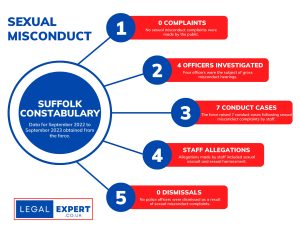
Suffolk Constabulary dealt with 7 sexual misconduct allegations from staff in the last year.
Amongst the allegations included sexual assault, sexual harassment and inappropriate sexual comments.
One allegation involved inappropriate communication, sexualised comments and behaviour.
The data, which covers October 2022 to October 2023, was obtained from Suffolk Constabulary via a Freedom of Information request.
However, no sexual misconduct complaints were made by the public.
In addition, no officers in Suffolk Constabulary have been dismissed as a result of sexual misconduct allegations.
Norfolk Constabulary
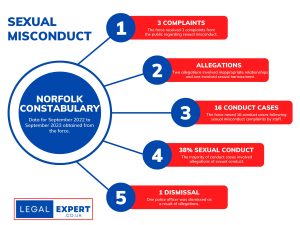
Norfolk Constabulary dealt with 16 sexual misconduct allegations from staff in the last year.
The most common allegation made by staff was sexual assault, which accounted for 38% of allegations recorded between October 2022 to October 2023.
Other common allegations included inappropriate communications (25%) and sexual harassment (19%).
A Freedom of Information request to Norfolk Constabulary further identified that 3 public complaints were made against the force regarding sexual misconduct.
Two incidents involved an inappropriate relationship whilst one case involved sexual assault.
Just one officer in Norfolk Constabulary was dismissed in relation to sexual conduct in the last year.
Hertfordshire Constabulary

There were 18 sexual misconduct allegations made against Hertfordshire Constabulary in the last year.
A Freedom of Information request uncovered that out of 18 sexual misconduct allegations made between October 2022 to October 2023, a total of 16 were made by staff.
Whilst the most common incident alleged related specifically to sexual misconduct, other common incidents included allegations of sexual assault, sexual harassment and rape.
A further two complaints made against the force by members of the public involved allegations of inappropriate sexualised behaviour and an abuse of position for sexual gain.
Six police officers were dismissed from the force as a result of sexual misconduct complaints during the same period.
Cambridgeshire Police
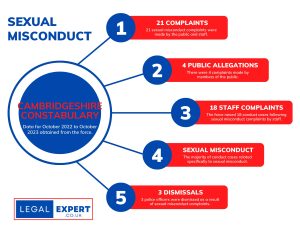
A total of 21 sexual misconduct allegations were made against Cambridgeshire Police in the last year.
Out of the allegations, 18 were made by staff between October 2022 to October 2023.
The most common allegation reported by staff related specifically to sexual misconduct, which accounted for 10 complaints.
Two incidents involved sexual assault allegations whilst another two complaints were about rape.
There were also isolated complaints about sexual harassment, abuse of position for sexual misconduct and inappropriate sexualised behaviour.
A further four complaints were made by members of the public, including two allegations of sexual assault.
One complaint regarded an abuse of position for sexual gain whilst another involved a sexual harassment allegation.
Three police officers were dismissed from the force as a result of sexual misconduct allegations in the same period.
Bedfordshire Police
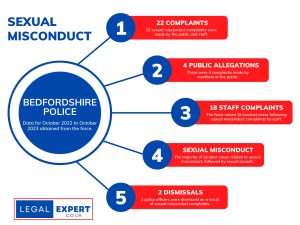
A total of 22 sexual misconduct allegations were made against Bedfordshire Police in the last year.
Four of those complaints were received from members of the public between October 2022 to October 2023.
Two allegations related to inappropriate sexualised behaviour, whilst another involved a sexual assault allegation.
A further incident was reported to the force regarding sexual harassment.
Out of the 18 complaints received from staff in the same period, around 44% related to sexual misconduct whilst 27% involved a sexual assault allegation.
Complaints were also made by staff alleging rape and sexual harrassment, with both incident types each making up 11% of allegations.
One incident involved an allegation of abuse of position for sexual gain.
Just two police officers were dismissed from Bedfordshire Police during this period.
Humberside Police

A total of 16 sexual misconduct complaints were made against Humberside Police in the last year.
Three of the complaints were lodged by members of the public between October 2022 to October 2023.
Amongst the allegations made by members of the public included sexual assault, harassment and rape.
Out of the remaining 13 sexual misconduct complaints made by staff, the majority of allegations related to sexual assault, rape or other sexual conduct.
One incident involved an allegation of sexual harassment.
During this period, no police officers have been dismissed from the force for sexual misconduct.
Cheshire Constabulary

Cheshire Constabulary received 16 complaints regarding sexual misconduct this year.
Half of those complaints were made by staff between October 2022 to October 2023.
Around 63% of complaints alleged sexual harassment, whilst the remaining involved allegations of sexual assault.
Out of the 8 complaints received from the public during the same period, 50% involved sexual assault allegations.
There was also an isolated incident where sexual harassment had been alleged.
Three police officers would have been dismissed but ultimately resigned.
Nottinghamshire Police

Nottinghamshire Police staff members raised 40 complaints regarding sexual misconduct this year.
Amongst the allegations made by staff included sexual assault, sexual harassment, abuse of position for sexual purpose and other sexual conduct.
A further 12 sexual misconduct complaints were made against the force by members of the public between October 2022 to October 2023.
Allegations included abuse of position for sexual purpose and also for the purpose of pursuing an inappropriate emotional relationship.
Members of the public also alleged incidents of sexual assault and sexual harassment.
West Yorkshire Police

A total of 49 sexual misconduct complaints were lodged against West Yorkshire Police this year.
A Freedom of Information request made to the force revealed that more sexual misconduct allegations were raised by staff than the public between October 2022 to October 2023.
Out of complaints made by staff members, a quarter related to inappropriate sexual behaviour and comments.
Around 18% of staff complaints were linked to inappropriate sexual comments whilst sexual assault formed 13% of allegations.
The majority of sexual misconduct complaints made by members of the public related to sexual assault, which accounted for 40% of allegations.
Hampshire Constabulary
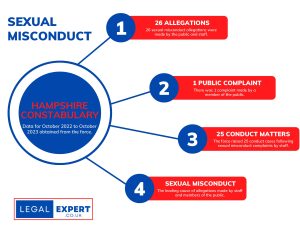
Hampshire Constabulary has received 26 sexual misconduct complaints in the last year.
One of those complaints was made by a member of the public and involved allegations of sexual assault.
The remaining 25 complaints were raised by staff at Hampshire Constabulary.
Around 56% of the complaints lodged by staff between October 2022 to October 2023 related directly to sexual misconduct allegations.
In contrast, 44% of complaints were made as a result of sexual offence allegations.
Thames Valley Police
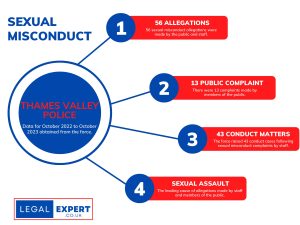
Thames Valley Police have received 56 sexual misconduct complaints in the last year.
Figures obtained from the force via a Freedom of Information request revealed that 43 of those complaints were made by staff.
Sexual assault was the leading allegation made by staff, making up 40% of all staff complaints regarding sexual misconduct.
Sexual harassment was the second most common allegation, accounting for 30% of complaints.
Similarly, out of 13 sexual misconduct complaints made by the public between October 2022 to October 2023, sexual assault was the most common allegation.
There were also two incidents where police officers allegedly abused their position of power.
In the same period, 6 police officers were dismissed at hearings.
However, it should be noted that the dismissals may be as a result of investigations that started prior to October 2022.
Wales

Sexual assault is the leading cause of sexual misconduct complaints made against police forces in Wales.
Out of 34 sexual misconduct complaints received from forces, around 56% were raised as a result of sexual assault allegations.
The figure of 34 complaints was obtained following a Freedom of Information request submitted to police forces in Wales.
Although Dyfed-Powys Police, North Wales Police and South Wales Police were able to provide data covering October 2022 to October 2023, Gwent Police denied the request.
Figures indicated that South Wales Police dealt with more sexual misconduct complaints than any other police force in Wales during this period.
The force received 24 complaints, 3 of which were made by members of the public and related to sexual assault.
Staff complaints resulted in 21 conduct matters being raised by South Wales Police.
A total of 10 conduct matters were raised due to allegations of sexual assault, while a further 9 were in relation to sexual harassment.
There were 7 police officers dismissed from South Wales for sexual misconduct in the same period.
North Wales Police dealt with 8 sexual misconduct complaints, half of which were raised by members of the public and related to sexual assault.
One police officer was dismissed arising from a conviction for sexual assault.
Dyfed-Powys Police received no sexual misconduct complaints from the public, but did receive two complaints from staff due to sexual assault allegations.
Just one police officer was dismissed for sexual misconduct.
































